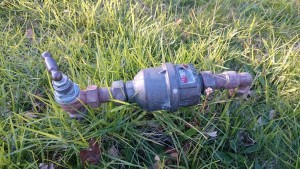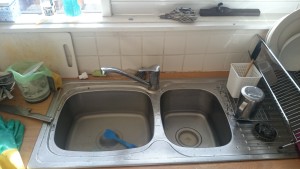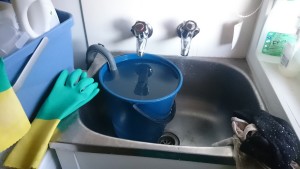
This billing period, our water usage was half of what it was at this time last year. Half!! We’re pretty stoked, because in the last twelve months, we have been doing our darndest to get our water usage as low as we can. We’ve realized that every litre of water that we allow out of our taps costs us money when the bill comes. So in halving our water usage, we have also halved our water bill. Becoming water efficient saves you money or helps you conserve your water if you are on tank water. I’ve found that this process has also helped us become aware of how we may be wasting water, making us better stewards of the resources God has given us.
So here are some dead easy tips to help you reduce your water bill too!
Our water saving strategies fall into two broader categories:
1) Minimise water usage
2) Repurpose as much water as possible
We try to minimise our water usage by:
- Showering or bathing every second day, rather than every day, and keeping our showers short.
This is one of the two biggest factors that has brought our water usage down. To some, this may seem gross, but really, we do not need daily showers. We decided to cut our showers to once every second day after reading about how daily showering strips our skin of their natural oils and also washes vitamin D off the skin before the body has time to absorb it. If we have gotten particularly grubby or sweaty for some reason, we may take a shower on our usual ‘day off’ but otherwise we will go without, or give ourselves a “sponge bath” with a wet face washer. - Avoiding doing anything under running water with no plug in or bucket to catch the water. This is the most inefficient way to use water. We try to reserve this sort of water usage to washing our hands after using the toilet and other more dirty washing that we don’t want to stay in the sink like car grease or after handling raw meat. Even in these cases, we try to minimize our water usage by:
- Using short blasts of water, rather than leaving the tap going steadily;
- Using a thin stream of water or;
- Putting the plug in or a bucket/tub under what we’re washing so we can catch and repurpose the water (depending on what we’re washing).
- Minimising the number of times we flush the toilet
A ‘full flush’ of your toilet can use as much as 9 litres of water. For an average family of 4, that could be up around 50 litres per day or 350 litres a week! So to reduce that water usage, we have a system where when more than one of us needs the toilet, we’ll flush once when we’ve all gone, rather than after each person. We also won’t bother flushing if one of the kids only does a mostly clear wee that doesn’t really smell. - Using minimal amounts of water to wash dishes.
We wash and rinse dishes in maybe 2 inches of water in the sink, not under the tap. For small amounts of dishes, we may even just wash them in a pot or bowl that we’ve used for that meal. - Washing veggies in a bowl.
We’ll wash veggies under the tap over a bowl and stop the tap when there’s enough water in the bowl to continue washing. I’ve also washed lettuce in our salad spinner like this, lifting the sieve layer out once done and empting the water into another container before spinning. - Using a cup when brushing teeth.
This is a trick we learnt from camping. Fill half a plastic cup with water, wet your toothbrush, put paste on, brush, spit in the sink, rinse your mouth from the cup, rinse toothbrush from cup then tip the remaining water in the sink to rinse any remaining residue from the sink. To compare, one night I tried using my old method of rinsing my brush and mouth from the running tap, cupping my hands to rinse my mouth, and left a bucket under the tap to see how much water I used. There was at least 2 cups of water in the bucket, compared to the half a cup I now use. So this technique can cut your teeth brushing water usage by at least 75%! - Wiping things with a damp or wet cloth, rather than washing them under the tap.
This has been particularly useful whether it’s wiping my food covered hands, or wiping a knife that’s just been used to cut cheese so I can use it cut fruit. - Rinsing food out of containers by putting a small amount of water in and then shaking. This uses much less water compared to keeping the tap running until all food/sauce is gone. It works best for lidded containers with the lid on, but you can get some amount of food off with an open top too. Just be careful not to shake the water out all over yourself!

We try to repurpose as much water as possible by:
- Using grey water to refill the toilet. This was the other major factor that saw our water usage drop significantly. Once the kids have had a bath, we turn the toilet cistern tap off so that it won’t refill after a flush. The next time we use the toilet, we hit the flush button as usual, then remove the cistern lid and, using plastic buckets, refill the cistern after each flush with the kids’ bath water. We also have four buckets in the shower to catch run off. We usually run out of grey water before the next bath so we’ll turn the tap back on and clean the toilet when it’s running on tap water again.
- Catching water in a tub when waiting for the hot water to come.
You can do this with any tap, whether in the bathroom, laundry or kitchen. When doing this at the kitchen tap, we’ll often just pour the water into our filter jug to use as drinking water. - Using water from steaming or washing vegetables to wash dishes.
One of the nifty things about using water from steaming vegetables is that if dinner doesn’t take too long, the water may even still be warm. - Catching water from the washing machine in a bucket.
I don’t tend to do this for laundry loads containing cloth nappies, but for loads of only clothes, we’ll easily fill a bucket, or more if we are in the room to change the bucket when it’s full. We usually use this grey water for the toilet, but if you use grey water safe detergent you may be able to use it on the garden. - Leaving the plug in the kitchen sink.
To catch odd bits of water. You could also leave a tub in the sink instead. You’ll be amazed how much water you catch over the course of a day! - Leaving the dish washing and/or dish rinsing water in the sink.
We’ll use this water for quick hand washes, soaking dirty dishes while they are waiting to be washed properly and if it’s not too dirty we’ll wet and wash our kitchen cleaning cloths in it.

I’ll confess, we aren’t perfect at doing all of these things every day. Sometimes I forget to put a tub under the tap, or in the laundry trough when there’s a clothes wash on. But on the whole, we are trying to be conscious about our water usage and do these sorts of things at every opportunity. We are no less clean or healthy for doing it, but are a bit the richer for it. They’re so easy and, for the most part, are completely free! The best bit is, the more we pay attention to these details, the more we become conscious of ways we can save more water and waste less.
Do you have any other nifty water saving ideas? Please share them in the comments below!
Originally posted 2015-06-15 12:00:31.
